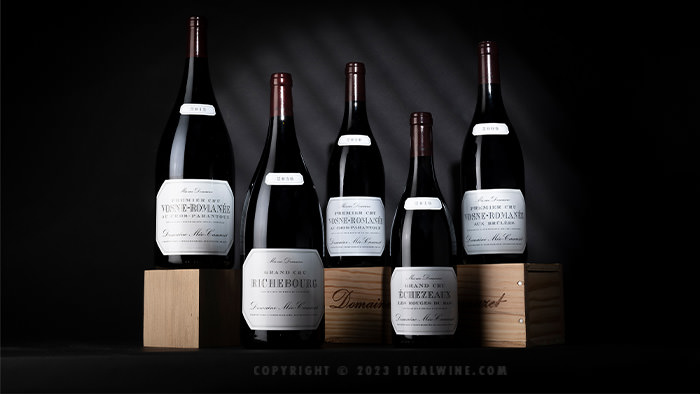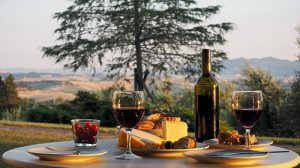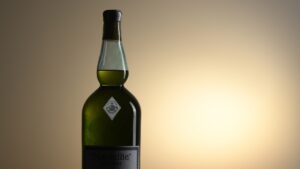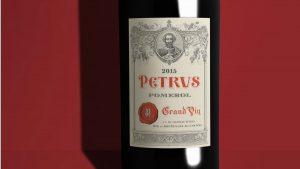
Domaine Méo-Camuzet is a true jewel of the Côte de Nuits. The quality of their wine makes their bottles particularly sought after amongst wine enthusiasts around the world. Their quality is in part thanks to their great terroir and in part to the talented winemaker Jean-Nicolas Méo. This outstanding winemaker, trained by the legendary Henry Jayer, was able to develop a truly unique style at his domain, which is certainly classed among Burgundy’s elite wineries.
Velvety on the mouth, an aromatic concentration and controlled balance surround the legendary Pinot Noir that defines the identity of this domain’s wine. This is made possible by high quality vines, not discounting the great work that is carried out in the vineyard. The winemaking process takes place in concrete and stainless-steel vats with a cold pre-fermentation maceration, daily pumping over and gentle punching down. This is followed by careful ageing in barrels, which are chosen for the quality of their staves. The domain often works with cooperage expert François Frères who provides their very best products. The wines are typically aged with a significant proportion of new oak, but light to medium heating allows them to obtain an elegant oak influence which is one of the signature aspects of the domain. After a long refinement process in the bottle, the oak influence merges with the fruit to create a magnificent balance.
We recently contacted Jean-Nicolas Méo, the man behind the wines, to tell us all about the secrets found in this auction.
Can you tell us a little about the wines going up for auction? What vintages and climats will be available?
The great majority of bottles offered in this auction are drinking really well already.
2005 and 2009 are very fine vintages. We’ve kept some of these bottles at the domain because we knew from the time they were made that the wines had great potential.
2005: Beginning to soften, this was a false-heat vintage with sunny conditions but not excessively so. The wines are concentrated but not too rich and they contain a good level of acidity. They are still a little tight, but they are beginning to reveal their elegance. This is a great vintage for ageing, and it is far from the end of its journey.
2009: Another great year, and a typical warm vintage which has evolved really well. The wines have tightened a little, having lost some of their richness and sunny characteristics. It has thus become a very balanced vintage.
2010: This is a vintage with a great reputation; it exudes lots of finesse, tension, and delicateness. Though it resembles 2005, it perhaps displaying more finesse and a little less concentration.
- Richebourg and Echezeaux Grand Cru, Corton Grand Cru Les Perrières, and Vosne-Romanée Premier Cru Aux Brulées are available in this vintage.
2011: This is a vintage that can be enjoyed from 2-3 years after bottling. It is a less homogenous vintage than that of 2010 or 2012, but it still gives us some pleasant wines with beautiful texture and balance. This vintage should not be neglected simply due to its “ready to drink” status.
2012: Another great vintage with high quality wines even though they didn’t receive the critical praise that they deserve. It’s a year that gave us ripe wines, while avoiding an alcohol percentage that is too high. Therefore, they are concentrated yet not overwhelming, with a lot of finesse. The vintage is starting to really relax, and we are just at the beginning of its opening-up phase.
2013: This was a vintage deemed difficult as it was cold and late to ripen. However, for the same reasons, it has retained a lot of the freshness and brilliance of the fruit. [Jean-Nicolas recently offered a tasting of 2013 Vosne-Romanée Village to sommeliers who really appreciated it.] The vintage is guided by beautiful acidity, freshness of the fruit and a surprizing softness. It is important to give these wines some more time in the cellar to age, as the Grand Crus are not yet ready.
2014: A true vintage of balance, driven by its finesse and harmonious levels of maturity, acidity and tannin. However, these wines are not yet in their optimal tasting window and should be cellared for at least 2-3 more years. For the most patient wine enthusiasts, these wines hold pleasant surprises within.
2015: I have enormous appreciation for this warm vintage, which is already drinking well (with the exception of Aux Brulées and Echezeaux which should be aged for at least another 5 years). For me, it is a very balanced vintage, especially between the concentration and tension, and is unquestionably a terrific year.
2016: This is a vintage with beautiful chemistry that has a pleasant and joyful side to balance its riper profile. The wines offered from 2016 are already pleasant to drink in their youth. However, they would certainly benefit from further ageing as well.
Can you tell us a little about Cros Parantoux, the beautiful plot of land cleared by Henri Jayer, the legendary winemaker who makes Burgundy enthusiasts shiver with anticipation?
This is a vineyard that became legendary in the 1980s, even though it had been known about for a long time and was well regarded when we look back to the 1855 Laval classification. The plot was progressively abandoned until Henri Jayer decided to plant vines on it in 1950, using dynamite to make it workable. He sensed the potential of this great, yet untapped, terroir. It is crazy to think that this terroir was planted with Jerusalem artichokes during the 1940s given what we know about its quality now. A great example of the intersection of a terroir and a truly talented man.
Cros Parantoux is colder than Richebourg due to its position at the edge of the woods. Richebourg is already fresh, but Cros Parantoux vines ripen even later. This is a wine with great acidity. It’s demonstrative and very open with a lot of different aromas. It must be given time to age in order to fully realise its potential.
Are there any climats that you consider underestimated by wine enthusiasts which you would like to shed more light on?
I think that we’ve had the good fortune to take advantage of some beautiful terroirs in Nuits-Saint-Georges, the premiers crus Aux Boudots and Aux Murgers. These are magnificent terroirs producing great wines for ageing. Though the appellation is a little neglected today, 40 years ago, the wines of Nuits-Saint-Georges played a big role in the reputation of Vosne-Romanée.
The Premier Cru Aux Boudots produces wines whose delicate charm approaches the expressions of Vosne-Romanée, with a rounded fleshiness that contrasts with the austerity typically found in Nuits-Saint-Georges. The Premier Cru Aux Murgers packs a little more acidity and ageing potential. These are wines that radiate powerful aromas and a wild side balanced by their captivating freshness.
These are therefore, two beautiful crus which should not be neglected, as they can offer fantastic moments in their tastings.
Corton is another under-estimated climat. Corton Les Perrières is a great terroir with plenty of minerality whose stony soil brings added finesse to temper its otherwise powerful and tannic structure. These wines require quite a bit of ageing, with the 2010 presented in this auction still needing a little more time. There is also the Corton Clos Rognet, which exudes natural opulence and comes from very old vines. These wines are smooth and charming with controlled acidity, and yet they still age very well. For the most patient collectors, they hold pleasant surprises which are only revealed with time.



